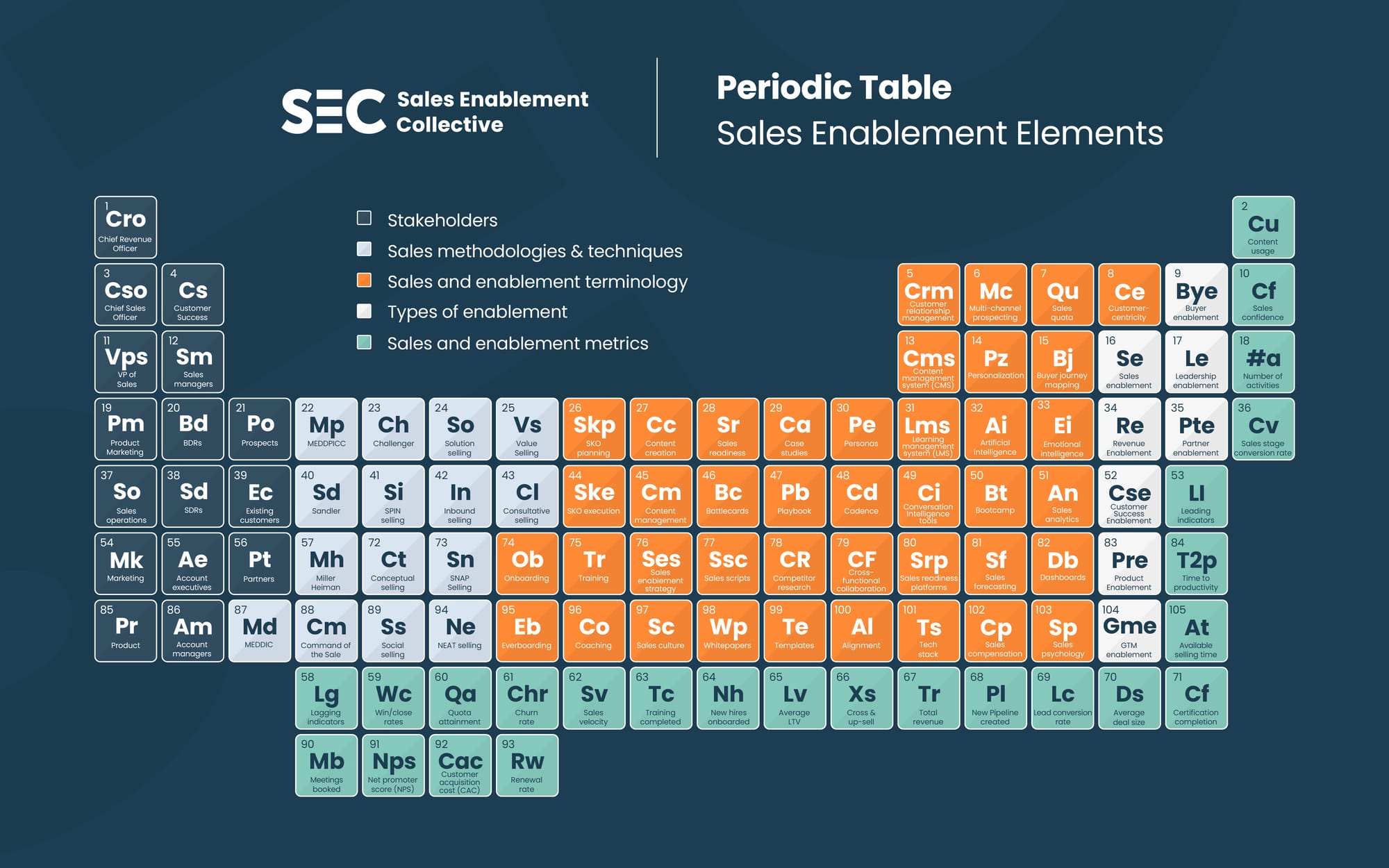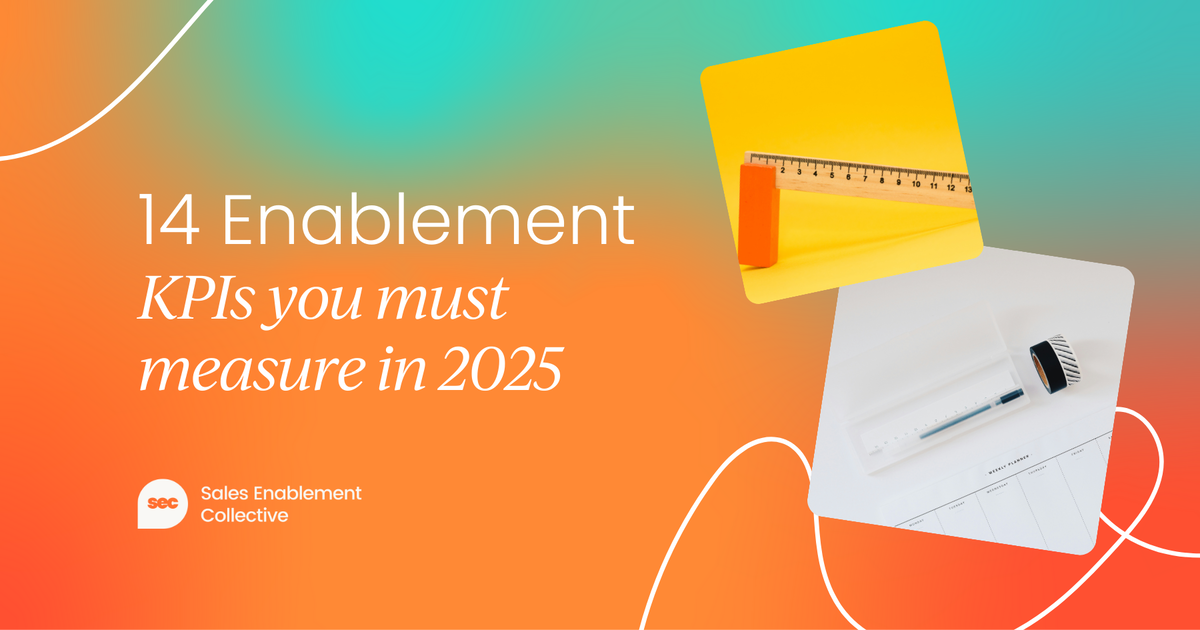One of the most fantastic things about sales enablement is how diverse it can be, and there are a huge variety of people with different skills and talents capable of thriving in the role.
Sales enablement professionals come from all kinds of backgrounds, whether it’s sales, learning and development, marketing, or something else - and each background lends itself to different parts of the job.
With that in mind, we’ve identified what we believe to be the key elements that make up the wonderful role of sales enablement.
And so, we've created this periodic table of elements, where we detail everything that a great sales enabler needs to know to reach the top of their game.

Want the table in poster form? Download the files for free below. If you'd like to share it on any of your socials, we would appreciate the tag!
Stakeholders
Enablement is an incredibly cross-functional department, and as a result there are a lot of stakeholders to keep in mind when building out programs. Here’s the ones that stuck in mind for us:
Cro 1: Chief Revenue Officer: If your organization has a Chief Revenue Officer, how well you communicate and collaborate with them will be the difference between surviving and thriving as an enablement team. The CRO is laser-focused on revenue goals, and as an enablement team much of your work will be centered around these goals as well.
Cso 3: Chief Sales Officer: As with the CRO, the Chief Sales Officer’s objectives and sales enablement’s go hand-in-hand, making it a partnership that requires regular communication to drive organizational success.
Cs 4: Customer success: Whether you’re in sales enablement and working on supporting the sales team, or if you fall into the revenue/GTM enablement banner and have more direct involvement with customer success, it remains a key partnership. The prospect’s journey doesn’t end once a deal is closed, so it’s imperative that the handover to your CS team is seamless.
Vps 11: Vice President of Sales: Just like the CRO and CSO, the VP of Sales is a senior sales position that you need to maintain a good working relationship with in enablement, as your efforts to enable the sales team ultimately affect their goals.
Sm 12: Sales managers: As a sales enablement professional, frontline sales managers are one of, if not the most important connection you form. They’re the ones who interact with the sales team on a daily basis and know them best, and can help you make your enablement programs tick.
Pm 19: Product marketing: Product marketing and sales enablement often go hand-in-hand, whether it’s through collaboration on content creation, messaging, or something else. Whatever it may be, it’s always a good idea to be in the loop with what product marketing is up to if you’re running an enablement team.
Bd 20: BDRs: While earlier we mentioned that frontline sales managers are probably the most important stakeholders in enablement, it goes without saying that sales reps like Business Development Representatives (BDRs) are key to sales enablement - without sales reps like them, who is there to enable?
Po 21: Prospects: While they’re not internal stakeholders, prospects must be front of mind for any sales enabler. At the end of the day, your sales enablement efforts are about affecting your sales team’s interactions with prospects.
So 31: Sales operations: Sales Ops is an important cog in any functioning sales org’s machine, and with its focus on optimizing the sales process and the keen eye it keeps on sales metrics, it’s a natural partner to your enablement activities. You’re missing a trick if you’re not collaborating with Sales Ops as an enabler.
Sd 38: SDRs: Everything we said about BDRs applies here! Sales Development Representatives (SDRs) are one of the main targets of your enablement programs, making them an important stakeholder and a group you want to get to know well.
Ec 39: Existing customers: Existing customers are stakeholders for a similar reason that your customer success team is. There’s plenty to learn from existing customers that can be used in case studies that’ll attract prospects, for starters. That’s not mentioning the fact that churn rate is a vital metric, especially in the world of SaaS.
Mk 54: Marketing: Marketing and sales alignment often makes or breaks an organization’s sales process, and this is where enablement can step in and act almost like an intermediary between them, ensuring a proper two-way flow of information.
Ae 55: Account Executives: SDRs and BDRs aren’t the only sales reps that you should pay attention to as a sales enabler! AEs are important stakeholders within the enablement ecosystem.
Pt 56: Partners: As partner enablement becomes more and more common among organizations, channel sales enablement is becoming more popular even as your partners natural become more prominent enablement stakeholders.
Pr 85: Product: While the product team might not be as close a stakeholder as some of the other functions listed, the sales reps you are enabling are trying to sell is at the heart of what the product team is doing.
Am 86: Account Managers: We don’t want to repeat ourselves, but the importance of keeping the whole customer journey, including post-sale, in mind can’t be stressed enough, especially if your domain stretches beyond sales enablement into broader enablement.

Sales methodologies & techniques
Md 87: MEDDIC: This acronym stands for Metrics, Economic Buyer, Decision Process, Decision Criteria, Identify Pain, and Champion. These act as a checklist for sales reps to help guide their sales process. Without knowing the details of these areas, closing a deal becomes difficult.
Mp 22: MEDDPICC: An expanded version of the MEDDIC acronym, adding Paper Process and Competition as criteria that need to be identified.
Ch 23: Challenger: The Challenger sales method doesn’t focus on building relationships with potential customers. Instead, it’s based on encouraging your salespeople to emulate the behaviors of high-performing “challengers” by being problem solvers who take initiative.
So 24: Solution Selling: This is a sales methodology which involves reps considering a prospect's overall needs, so they can provide products that will best solve their individual pain points and concerns, rather than just selling whatever to whomever.
Vs 25: Value Selling: Value Selling is a sales methodology that focuses on highlighting the value your product will bring to the customer, with a particular emphasis on benefitting the prospective customer.
Sd 40: Sandler: The Sandler Selling System puts particular emphasis on qualifying leads and acting in a consultative manner. Its seven stages are often portrayed as a “submarine”, with each stage needing to be secured before moving on to the next.
Si 41: Spin Selling: The SPIN sales methodology is all about asking four distinct types of questions on sales calls in order to get a thorough understanding of a prospect’s pain points. Rather than having sales reps focused on nothing but pitching, SPIN selling puts them into a consultative selling role.
In 42: Inbound selling: Inbound selling is the idea that it’s more important to consult, support, and educate a potential buyer than pushing a product on to them. Through inbound selling, you ultimately guide the prospect to the buying decision.
Cl 43: Consultative selling: Consultative selling involves building a relationship with prospective customers by enquiring about their problems, understanding their needs, and adapting what you’re selling to their pain points.
Mh 57: Miller Heiman: devised by Robert Miller and Stephen Heiman, this methodology aims to be the most effective way of managing large & complicated B2B deals, using three steps: Categorizing, Determining, and Influencing.
Ct 72: Conceptual selling: Another of Robert Miller and Stephen Heiman’s creations, conceptual selling is based on the idea that customers buy the concept of a solution and not the solution itself.
Sn 73: Snap Selling: SNAP Selling is a methodology which ensures that sellers keep the buying process simple for prospects, helping them find value in a world of information overload.
Cm 88: Command of the Sale: The Command of the Sale methodology is based on working back from what’s most important for the prospect, and helping your sellers improve deal velocity and predictability through aligning sales activities with complicated buying processes.
Ss 89: Social selling: Social selling involves building relationships with prospects through social media, and building a lead generation strategy around having your sales reps directly interact with prospects through social platforms such as LinkedIn.
Ne 94: NEAT Selling: NEAT stands for Needs, Energy, Alignment, and Trust. This methodology focuses on bringing energy and enthusiasm to the sales process in order to build trust and meet the prospect’s needs and complete the sale.

Sales and enablement terminology
Crm 5: Customer Relationship Management: Customer Relationship Management (CRM) systems are tools designed for managing all of your company's interactions with current and potential customers. The data stored within includes contact information, interactions, and more.
Mc 6: Multi-channel prospecting: Multi-channel prospecting involves making contact with leads across a number of different channels, including email, phone, and social media, rather than relying on just one of those options.
Qu 7: Sales quota: As Gartner says, a sales quota is the performance expectation that sellers must achieve during a set time period to earn their target incentive pay. “Hitting quota” is a major motivation for sales reps, as they’ll earn more money doing so.
Ce 8: Customer-centricity: Modern sales is less about flogging your product, and more about finding the right customers - those that need your product. Customer-centricity is at the heart of sales today, and it means prioritizing the customer’s wants and needs in order to create a great product and achieve sales.
Cms 13: Content Management System: A Content Management System (CMS) is a tool designed to neatly organize and store all your sales content - think sales scripts, battle cards, playbooks, one-pagers, and more. The aim is for sellers to be able to easily find this information and provide it to leads.
Pz 14: Personalization: A key factor in modern selling, personalization means that your interactions with prospects are tailored to their unique circumstances, rather than being generic and sent en masse.
Bj 15: Buyer journey mapping: Mapping the buyer’s journey (from first interaction with you, to sale and beyond), is a great way to understand and analyze your selling process and reveal potential points of friction which could put buyers off.
Skp 26: SKO Planning: Sales kickoffs (SKO) are an important part of the sales and enablement calendar. They’re a chance to align sellers and set the tone for the upcoming year of sales, so planning and organizing these events to be engaging, relevant, and fun is something enablement teams should strive for.
Cc 27: Content creation: Sales content helps sellers sell better. From playbooks and scripts, to battle cards and one-pagers, it’s important for enablement to create (or facilitate the creation of) great content that reps can use to close deals faster.
Sr 28: Sales readiness: Sales readiness is a concept that while adjacent to sales enablement, is different. Sales readiness involves ascertaining whether sellers are properly equipped to close sales. Enablement is the process of preparing reps, while readiness is determining whether they’re actually ready.
Ca 29: Case studies: Customer case studies are powerful tools in a seller’s arsenal. Social proof, and evidence that their peers use and recommend your product, can be what convinces a prospect to buy.
Pe 30: Personas: These are fictional characters that represent the real market segments of a customer base. A buyer persona describes someone who will buy your product. This will likely be a more senior individual in an organization. Meanwhile, a user persona describes the person who will use your product or service. This may be a member of a sales team who works under the person who purchased the product.
Lms 31: Learning Management System: A Learning Management System (LMS) is a tool which allows for training programs to be administered and tracked, and overall is geared towards the development of the sales team’s skills.
Ai 32: Artificial intelligence: Artificial intelligence (AI) is technology that enables computers and machines to simulate human intelligence and problem-solving capabilities. In sales, AI can be used to support sellers through call analysis, coaching, email writing, and automation of elements of the sales process to name a few.
Ei 33: Emotional intelligence: Emotional intelligence (EQ or EI) is the ability to perceive, express, and regulate emotions. As sellers interact with prospects every day, dealing with prospects’ emotions and feelings, emotional intelligence is a skill in which they need to be trained in.
Ske 44: SKO Execution: Planning your SKO meticulously is all well and good, but you need to be able to execute and run the event on the day in order to get the maximum return.
Cm 45: Content management: Going hand-in-hand with content creation and your CMS, content management is a key aspect of enablement. There’s no point in creating great content if there’s no one using it or accessing it.
Bc 46: Battlecards: A sales battlecard provides a concise, at-a-glance summary of your value proposition, answers to common customer queries and explains competitive differentiators.
Pb 47: Playbook: A sales playbook is a go-to guide for your salespeople to refer to at a glance. It should hold all the key information that a sales rep would need to know while selling.Your playbook should contain all the sales plays, prospect information, tactics, and sales methodology your sales team will need to close a deal.
Cd 48: Cadence: In sales terms, cadence refers to how often you contact your leads as part of your sales process. A sales cadence will often have touch points across multiple channels, for example starting with a phone call on Day 1, then an email on Day 3, then a LinkedIn message on Day 7, etc.
Ci 49: Conversation Intelligence tools: These tools use AI to listen to sales reps’ calls and provide feedback and analysis on a whole host of criteria at scale. CI platforms can track a prospect’s mood, the number of times key words/phrases were used, and more to allow enablement and sales managers to assess the sales team’s performance individually and as a whole.
Bt 50: Bootcamp: Some organizations use sales bootcamps - intensive training programs over the course of 1-2 weeks - to get sales reps up to speed with the essential skills. This is often used to get newly-hired reps trained on the sales techniques they need to succeed.
An 51: Sales analytics: Per Gartner, sales analytics is used in identifying, modeling, understanding and predicting sales trends and outcomes while aiding sales management in understanding where salespeople can improve.
Ob 74: Onboarding: Onboarding, one of enablement’s primary responsibilities, is the process of providing newly-hired reps with the knowledge and skills necessary to perform in their role. The ultimate goal of an enablement team’s onboarding program is to prepare new reps so that they are able to sell effectively as soon as possible.
Tr 75: Training: One-to-many training is one of the many ways to improve the sales team’s skills. Training is used to teach reps the essential skills they need to thrive, as well as to implement organizational changes such as a new sales methodology.
Ses 76: Sales enablement strategy: Sales enablement’s influence is at its greatest when acting strategically and proactively, rather than reactively. Building a long-term sales enablement strategy is the most effective way to prove your ROI as a team and influence the organization in a positive way.
Ssc 77: Sales scripts: Sales scripts help ensure that each prospect is being given the same value proposition and that they have a seamless experience regardless of which rep they talk to. Each seller follows the script and therefore hits the correct talking points consistently.
CR 78: Competitor research: Inevitably, your competitors will come up during conversation with prospects who are exploring your options. Therefore, competitor research is essential so that your reps know where you’re a cut above, and what differentiators your product has that your competitors can’t match.
CF 79: Cross-functional collaboration: Enablement has to be on the same page with a whole host of stakeholders, from product marketing and sales leadership, to marketing and RevOps. Cross-functional collaboration is an essential part of ensuring alignment across your organization’s go-to-market teams and strategies.
Srp 80: Sales readiness platforms: Like LMS’, these platforms allow for training programs to be administered and tracked, and overall are geared towards the development of the sales team’s skills. Sales readiness platforms often contain exams or assessments to determine whether a rep is ready to sell based on their training results.
Sf 81: Sales forecasting: Sales forecasts provide future revenue estimates for each sales rep, which can then be consolidated into forecasts for the sales team as a whole. These are based on the amount of prospects/potential revenue in each rep’s pipeline, and the average percentage of deals in a pipeline which close.
Db 82: Dashboards: Dashboards across your tools like your CRM, CMS, and LMS can provide you with up-to-date data on the essentials your sales and enablement teams need to track.
Eb 95: Everboarding: Everboarding is the idea that onboarding shouldn’t be the end of a sales rep’s learning journey. Instead, reps should be “everboarded”, with continuous learning and development the core principle behind the concept.
Co 96: Coaching: One-to-one coaching is equally as important as one-to-many training, as it gives reps an opportunity to work on individual areas of improvement to better their performance. One-to-one coaching is a chance for reps to talk to a mentor from whom they can learn, grow, and set development goals.
Sc 97: Sales culture: Culture is an often-misunderstood element of sales. Organizations with a positive culture of encouragement and growth are more likely to succeed than those in which the sales team are criticized and not given opportunities to grow and improve.
Wp 98: Whitepapers: As content, whitepapers can help your reps highlight your organization’s reputation as a trusted authority in your product’s industry. Additionally, it provides prospects with something of value to them, without requiring them to purchase or spend money.
Te 99: Templates: Like scripts, templates provide a structure for sales reps to ensure they’re sticking to the plan set by the sales organization. Content like email templates can help remove the intimidation factor from a new rep who is sending a cold email to a prospect, giving them the confidence they’re doing things the right way.
Al 100: Alignment: Alignment goes hand-in-hand with cross-functional collaboration. Enablement team goals need to be aligned with the wider organizations to ensure that everyone is pulling in the same direction and towards the same, aligned goals.
Ts 101: Tech stack: A sales enablement tech stack often consists of a whole host of tools and technology designed to support sales teams and analyze performance. What’s key is to avoid “bloat” and that you’re only spending money on tools and tech that you actually use and get a benefit from.
Cp 102: Sales compensation: Compensation is the big motivator for sales reps - most organizations work with some sort of base + OTE structure, where sales reps are incentivized to hit their quota by being rewarded with a monetary bonus should they do so.
Sp 103: Sales psychology: Sales is about influencing and convincing prospects to buy your product or service, which means understanding the psychology behind customers, and what factors can and do influence their decision to purchase (positively and negatively) is an area worth studying.

Types of enablement
Bye 9: Buyer enablement: As the field of enablement developed and was proven to be effective, it naturally began to expand. Buyer enablement involves bringing that same level of empowerment that reps receive from sales enablement, to buyers through helping prospects navigate the wealth of information on the market today, and more.
Se 16: Sales enablement: Sales enablement is a strategy which encompasses coaching, training, content, technology, processes, and activities with the aim of supporting and empowering sales reps to move sales opportunities forward through knowledge-based interactions with prospects. In short? Sales enablement is about helping salespeople be better at what they do by providing them with support and training.
Le 17: Leadership enablement: It’s not just sales reps who can and should be empowered by enablement. Leadership enablement involves using enablement techniques and strategies to support more senior positions in the organization.
Re 34: Revenue enablement: Revenue enablement expands sales enablement’s purview from sales-only, to instead supporting and empowering all revenue-generating channels and customer-facing, revenue-generating roles. It’s sales enablement, but casting a wider net to support beyond the sales team.
Pte 35: Partner enablement: External partner enablement involves enabling companies that resell our products or services. These partners have their own customers and sell on your behalf, making them an extension of your company, so you need to enable their teams to sell and talk about your products as effectively as your internal sales teams do.
Cse 52: Customer success enablement: Customer success is a critical part of any organization, as retaining happy customers is cheaper and just as important as acquiring new ones. That means enabling customer success teams with best practices to improve their performance is an area with a lot of potential.
Pre 83: Product enablement: Enablement has proven to be effective in supporting and driving success across teams, which makes the product team a natural fit to receive enablement support as well.
Gme 104: GTM enablement: Go-to-market (GTM) enablement is the culmination of enablement’s expansion from sales and then revenue and beyond. Organizations that employ GTM enablement extend their level of support to any department involved in the GTM process of launching a new product or service, including product and often engineering teams too - in addition to the teams covered by revenue enablement.

Sales and enablement metrics
Cu 2: Content usage: How much a piece of content has been viewed, downloaded, or used by a rep or prospect
Cf 10: Sales confidence: A measure of how confident a sales rep is in their ability to move a deal through their pipeline and convert into a sale
#a 18: Number of activities: How many times in a day/week/month a rep did a certain activity, such as a phone call, email send, etc.
Cv 36: Sales stage conversion rate: How successful a rep is in moving a prospect from one stage of the sales funnel to the next. From stage one to two is one rate, from two to three another, and so on.
LI 53: Leading indicators: A group of metrics which cover everything that leads up to closing a sale, which can often give you an indication of how well your sales enablement inputs are impacting rep performance. Leading indicators are essentially predictive, looking at sales activities and using those to predict future success.
T2p 84: Time to productivity: The time it takes to onboard and ramp new sales reps to full productivity.
At 105: Available selling time: How much time a rep is spending per day/week/month actively selling to prospects, compared to non-selling time like training, coaching, and inputting to a CRM.
Lg 58: Lagging indicators: A group of metrics which measure the outputs after the fact - ie, the actual results. This includes win/close rates, quota attainment, and more.
Wc 59: Win/close rate: How many deals you successfully won out of your total opportunities, usually as a percentage.
Qa 60: Quota attainment: What percentage of sales reps successfully reached their quota over a set period of time.

Chr 61: Churn rate: The amount of customers who have stopped doing business with you. Essentially, attrition rate per month/quarter/year.
Sv 62: Sales velocity: A metric gaining popularity in sales enablement circles, used to measure the speed at which deals progress through the sales cycle and generate revenue. The result is a dollar value calculated as: (Opportunities x average deal value x win/close percentage) / average sales cycle length in months.
Tc 63: Training completed: The number of reps who successfully completed a training session or module out of the total number of reps.
Nh 64: New hires onboarded: The number of new hires who have been successfully onboarded over a set period of time.
Lv 65: Average LTV: The average amount of revenue a customer spends over the course of their lifetime with the business.
Xs 66: Cross- and up-sell: A group of metrics tracking the number of cross- and up-selling opportunities capitalized upon by reps over a set period of time.
Tr 67: Total revenue: Simply the total amount of revenue generated by either an individual rep or a sales team as a whole.
Pl 68: New pipeline created: The amount of revenue added to a rep or team’s pipeline over a set period of time.
Lc 69: Lead conversion rate: The percentage of leads which convert into new customers on a per rep or per team basis over a set period of time.
Ds 70: Average deal size: Simply the average deal size in revenue on a per rep or per team basis over a set period of time.
Cf 71: Certification completion: The number/percentage of reps who completed an assigned certification out of the total number.
Mb 90: Meetings booked: The number of meetings with prospects booked by a rep or team over a set period of time.
Nps 91: Net Promoter Score (NPS): NPS is a metric used to qualitatively measure customer or sales rep satisfaction through surveys. Enablement teams can use it to assess the enjoyability or effectiveness of training programs, for example.
Cac 92: Customer acquisition cost: How much it costs for your organization to attain a new customer. Measured by dividing the total expenses to acquire customers (your cost of sales and marketing) by the total number of customers acquired over a set period of time.
Rw 93: Renewal rate: The ratio of the number of customers who renewed their contracts in a set period of time, to the total number of customers who could potentially have renewed their contracts during the period.


Join 8,500+ of your sales enablement peers in SEC's Slack group! Idea-share, network, and ask questions in the community.


Sales enablement insider
Thank you for subscribing
Level up your sales enablement career & network with sales enablement experts
An email has been successfully sent to confirm your subscription.
 Follow us on LinkedIn
Follow us on LinkedIn








.svg)